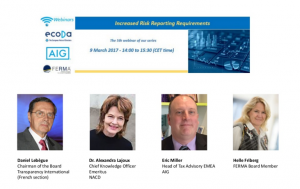Helle Friberg, FERMA board member, reports on the webinar on increased risk reporting requirements held on March 9 and covering country-by-country financial reporting and non-financial reporting.

Increasing disclosure by companies of their financial and non-financial results around the world exposes them to new scrutiny. We need to risk manage this process of greater transparency, or businesses could face damaging, unforeseen consequences.
Company reports are no longer limited to financial and economic information for shareholders prepared according to generally agreed accounting principles, as they were in the past. Today, all sorts of stakeholders are looking for information about the way companies operate: clients, employees, NGOs, public bodies and business partners. As a result of new European and international requirements, large enterprises will be obliged to report country-by-country financial results and provide information on the social, human and ethical aspects of their activities.
Management needs to be aware of the possible consequences – positive and negative – disclosing more business information to the public. Certain figures are going to pop up and could easily be open to misinterpretation taken out of the context of the company’s whole value chain. Special purpose entities and captive insurance companies, for example, are likely to show a large revenue compared to the number, if any, of employees, because the management is usually outsourced. That could increase existing suspicions so the company must be able to show the real purpose and risk management value of such arrangements.
The content of the report should therefore be risk-assessed to anticipate possible difficulties when it has been released. The risk manager should be one of the strategic advisors that the board uses when talking about transparency, because she or he has a tremendous knowledge of what could damage the company’s reputation. The risk manager already produces internal risk reporting for the management and the board and is working with a risk database which contains much useful information.
When a company has put figures and data out into the public domain, it can be very vulnerable and exposed. Published information is open to misunderstanding – with potentially big positive and negative consequences for the business. Done correctly, it can create a possibility of using the report as a strategical tool in communications with investors, clients, and employees. The quality of the reported data, especially on risks, is essential. Businesses should take advantage of what the risk manager can bring to this new regime of transparency.
Helle was a speaker in the latest of the webinar series on the risk conversation with the board, organised by FERMA, the directors’ organisation ecoDA and AIG and held on 9 March.
Other speakers were Alexandra Lajoux, Chief Knowledge Officer Emeritus, National Association of Corporate Directors; Daniel Lebègue, Chair of Transparency France and Eric Miller, Head of EMEA Tax Advisory at AIG. The moderator was Roger Barker.
The presentation is available here:
Increased Risk Reporting Requirements: 5th webinar with ecoDa and AIG from FERMA